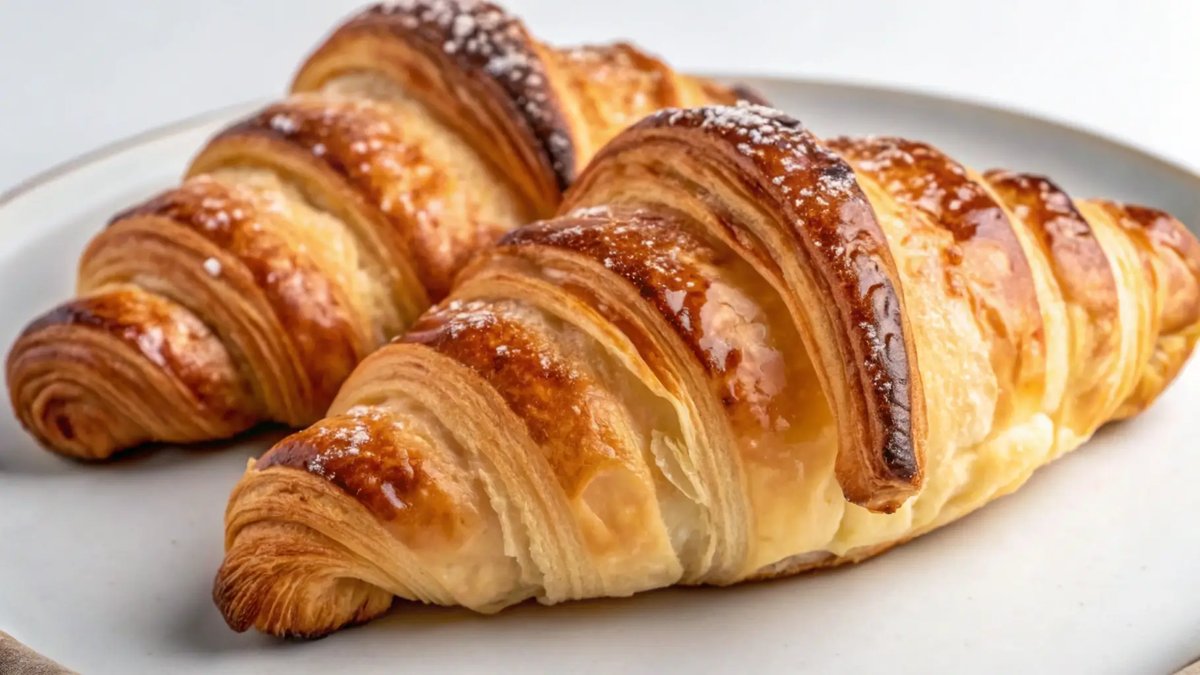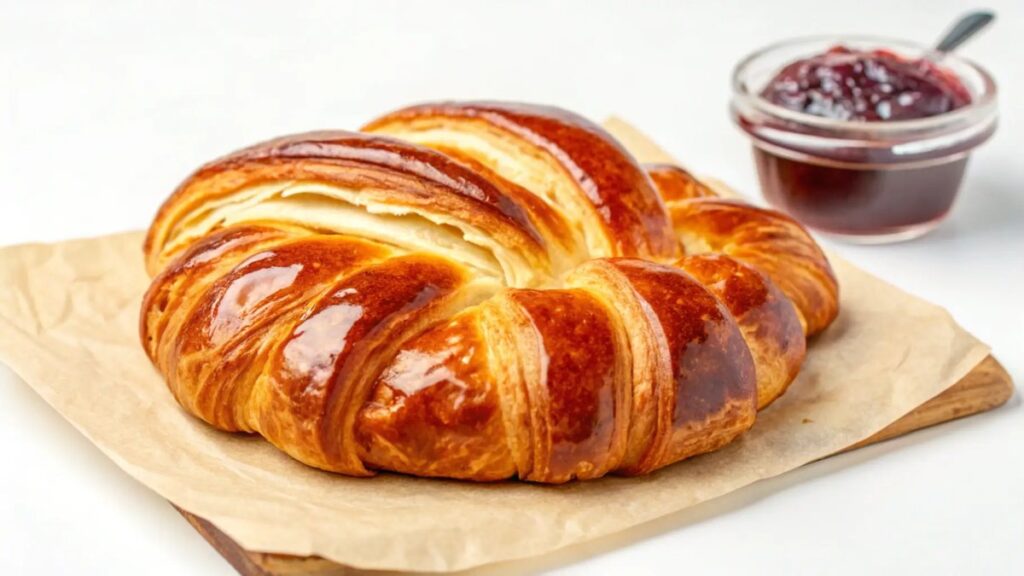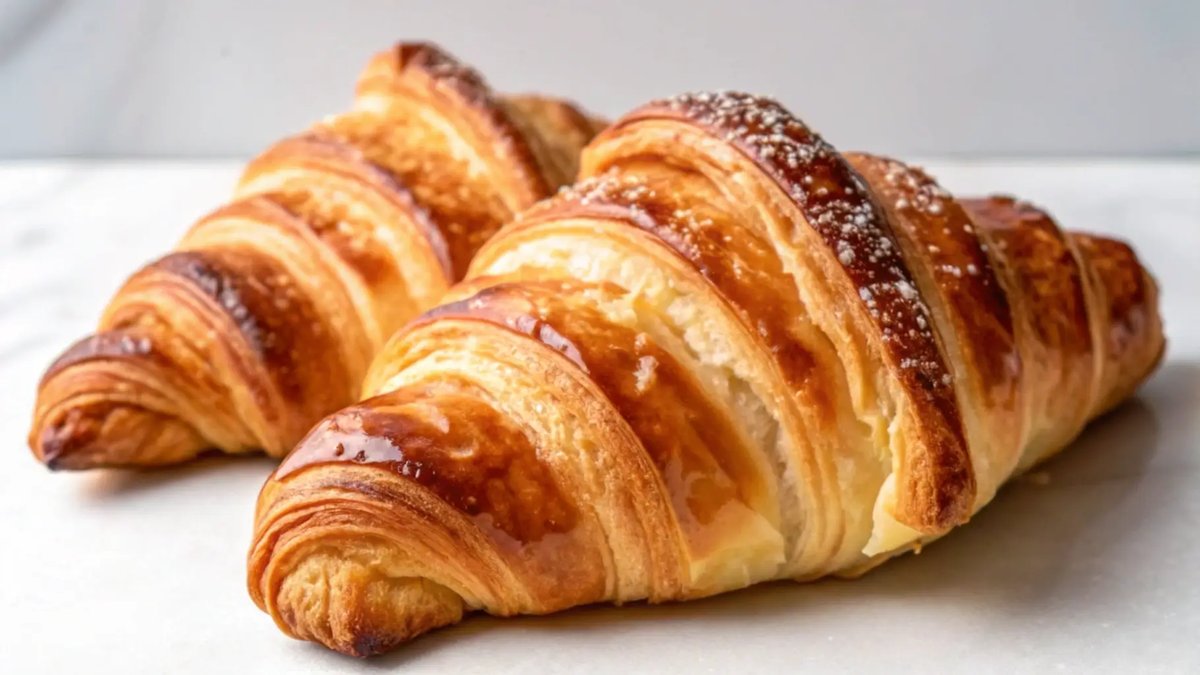Introduction to Gipfeli
Gipfeli, the Swiss version of a croissant, is a beloved breakfast treat that holds a special place in Swiss culture. Known for its light and flaky texture, this crescent-shaped pastry is a staple in bakeries and homes across Switzerland. While similar to the classic French croissant, Gipfeli has its unique characteristics, making it a delightful choice for sweet or savory cravings.
What Are Gipfeli?
Origins and Cultural Significance of Swiss Croissants
The roots of Gipfeli can be traced back to Switzerland, where it has become an integral part of the country’s culinary heritage. The name “Gipfeli” comes from the Swiss-German word for “crescent,” referencing its iconic shape. Unlike its French counterpart, the Gipfeli tends to be slightly less buttery and sweeter, reflecting the Swiss preference for balanced flavors.
Gipfeli vs. Croissant: Key Differences
While Gipfeli and croissants share similar origins, they differ in several ways:
- Texture: Gipfeli is denser and slightly less flaky than a croissant.
- Taste: It has a subtle sweetness, whereas croissants are typically more savory.
- Ingredients: Swiss Gipfeli sometimes include fillings like chocolate, nuts, or jam, adding versatility to its flavor profile.
These distinctions make Gipfeli a unique pastry with a distinct Swiss identity.
Ingredients Overview
Essential Ingredients: Flour, Butter, Milk, Yeast, and Sugar
At its core, the classic Gipfeli recipe calls for a few simple, high-quality ingredients:
- Flour: The base for structure and texture.
- Butter: Provides richness and enhances flakiness.
- Milk: Adds moisture and softness.
- Yeast: Essential for the pastry’s airy layers.
- Sugar: Balances the flavors and promotes caramelization during baking.
Special Additions: Nut Fillings, Chocolate, or Jam
To elevate the traditional recipe, many bakers incorporate special fillings such as:
- Nut spreads: Almond paste or hazelnut cream for a nutty twist.
- Chocolate: A decadent choice for sweet lovers.
- Jam: Offers a fruity burst of flavor.
Choosing Quality Butter for Authentic Flavors
For an authentic Swiss Gipfeli, using high-quality butter is non-negotiable. European-style butter, with its higher fat content, ensures the pastry achieves its signature richness and delicate texture.
Why Gipfeli Are a Breakfast Staple in Switzerland
Traditional Pairings with Coffee or Hot Chocolate
In Switzerland, Gipfeli is commonly enjoyed alongside a warm beverage like coffee or hot chocolate. This pairing complements the pastry’s buttery layers and enhances the overall dining experience. A hot cup of cappuccino or a frothy mug of Schoggi (Swiss hot chocolate) transforms Gipfeli into a luxurious breakfast or afternoon treat.
Their Versatility as Sweet or Savory Pastries
Another reason for Gipfeli’s popularity is its adaptability. Whether you prefer it sweet or savory, there’s a variation for every palate:
- Sweet Options: Nutella, almond cream, or fruit preserves.
- Savory Choices: Cheese, ham, or even herb-infused fillings for a sophisticated twist.
Gipfeli’s versatility and ease of preparation make it a cherished breakfast item that’s perfect for both casual mornings and festive brunches.
How to Make Gipfeli from Scratch
Crafting Gipfeli from scratch is a rewarding experience, as it allows you to create fresh and authentic pastries right at home. With a bit of patience and attention to detail, you can enjoy the same delightful flavors and textures found in Swiss bakeries. In this section, we’ll explore every step of the process, ensuring your Gipfeli turn out perfect.
Preparing the Dough
Step 1: Mixing Flour, Yeast, Sugar, and Milk
The foundation of Gipfeli lies in its dough, and achieving the ideal texture begins with combining the right ingredients. First, mix flour, sugar, and yeast in a large bowl. Gradually add warm milk, as this not only activates the yeast but also gives the dough a soft consistency. Stir gently until the ingredients are evenly incorporated.
Transitioning to the next step, kneading, ensures the dough develops the necessary elasticity.
Step 2: Kneading the Dough for Flakiness
Once the dough is mixed, transfer it to a floured surface for kneading. This is where the magic of Gipfeli begins to take shape. Knead the dough for about 8–10 minutes until it becomes smooth and pliable. The kneading process is essential for creating the flaky layers that make Gipfeli irresistible.
Remember, patience is key here. Proper kneading helps distribute the butter evenly, which is critical for the pastry’s structure.
Step 3: Resting and Proofing the Dough
After kneading, it’s time to let the dough rest. Place it in a greased bowl, cover it with a damp cloth, and allow it to proof in a warm place for about 1–2 hours. During this time, the dough will double in size, becoming airy and light.
Proofing not only enhances the dough’s texture but also makes it easier to work with when rolling and shaping. This step sets the stage for creating the iconic layers of a classic Gipfeli.
Rolling and Shaping
How to Roll the Dough to Create Layers
After the dough has rested, it’s time to roll it out. Begin by lightly flouring your work surface and rolling the dough into a large rectangle. This step is where the foundation for those iconic layers is laid.
Next, fold the dough into thirds—similar to folding a letter—and roll it out again. Repeat this process 2–3 times, as it creates the flaky layers that make Gipfeli stand out from other pastries.
Shaping Gipfeli into Crescent Forms
Now comes the fun part: shaping the Gipfeli. Cut the dough into triangles, ensuring each one is roughly the same size. Starting from the base of each triangle, roll the dough tightly toward the tip, forming a crescent shape.
To give the Gipfeli their characteristic curve, gently bend the ends inward. These small details add a touch of authenticity to your homemade Swiss croissants.
Tips for Even Layering
For the best results, ensure your rolling and folding are consistent. Uneven layers can affect the texture of the Gipfeli, so take your time during this step. Additionally, keeping the dough cold during the process helps maintain the layers and prevents the butter from melting prematurely.

Baking the Perfect Gipfeli
Choosing the Right Oven Temperature
When it’s time to bake, preheat your oven to 375°F (190°C). Achieving the correct temperature is crucial for evenly baking your Gipfeli without overcooking them.
Placing the pastries on a lined baking sheet ensures they bake evenly and retain their shape.
Brushing with Egg Wash for a Golden Finish
Before placing your Gipfeli in the oven, brush them with a light layer of egg wash. This step not only gives them their signature golden hue but also enhances their visual appeal.
For a sweeter variation, you can sprinkle a bit of sugar on top before baking.
Baking Time and Signs of Doneness
Bake the Gipfeli for 15–20 minutes, or until they are golden brown. Keep an eye on the pastries as they bake, as overcooking can result in a dry texture.
You’ll know your Gipfeli are ready when they’re golden, flaky, and slightly puffed. Allow them to cool for a few minutes before serving, as this enhances their flavor and texture.
Creative Variations, Serving Suggestions, and Expert Tips for Gipfeli
The art of creating the perfect Gipfeli recipe doesn’t end with just the classic version. In fact, there are endless ways to customize this beloved Swiss pastry to suit your preferences. From exciting fillings to savory twists, and tips to ensure your Gipfeli recipe is flawless, this section will inspire you to take your baking to the next level. Let’s dive in!
Creative Variations of the Gipfeli Recipe
While the classic Gipfeli recipe is undeniably delicious, experimenting with variations can make your pastries even more exciting. Whether you’re looking for a sweet treat or a savory delight, these ideas will help you add a unique twist to your Gipfeli recipe.
Sweet Fillings
To begin with, sweet fillings are an excellent way to elevate your Gipfeli recipe. Consider options like:
- Chocolate-filled Gipfeli: Add a piece of chocolate to the center of each triangle before rolling it into a crescent shape. The result? A gooey, indulgent treat that pairs beautifully with coffee.
- Jam or custard variations: Use your favorite fruit jams or custards to create a burst of flavor with every bite. Apricot or raspberry jam is particularly delightful.
- Almond paste or hazelnut spread: Spread a thin layer of almond paste or Nutella on the dough for a nutty twist to your Gipfeli recipe.
These sweet variations are perfect for breakfast, brunch, or even dessert.
Savory Options
On the other hand, savory variations of the Gipfeli recipe are just as irresistible. For those who prefer less sweetness, here are some savory ideas:
- Cheese and ham Gipfeli: Place a slice of cheese and ham on the dough before rolling. This savory option makes a hearty snack or light lunch.
- Herb-infused or pesto-style Gipfeli: Spread a thin layer of basil pesto or sprinkle fresh herbs like thyme and rosemary into the dough for a fragrant, savory pastry.
These savory options demonstrate how versatile the Gipfeli recipe can be, catering to a wide range of tastes.
Serving Suggestions
Now that you’ve mastered the Gipfeli recipe and explored creative variations, it’s time to think about how to serve them. Proper serving can enhance the enjoyment of these delightful pastries.
Best Beverages to Pair with the Gipfeli Recipe
A Gipfeli recipe is often considered incomplete without the right beverage. Pairing your pastries with complementary drinks is an essential part of the Swiss tradition. Here are a few options:
- Classic coffee or cappuccino: The robust flavor of coffee beautifully contrasts with the buttery, flaky texture of the Gipfeli recipe.
- Hot chocolate: For a more indulgent pairing, hot chocolate is a fantastic choice, particularly when enjoying sweet-filled variations.
- Herbal teas or lattes: If you prefer something lighter, chamomile tea or a frothy latte perfectly balances the richness of the Gipfeli recipe.
Presenting Gipfeli for Breakfast or Brunch
When serving Gipfeli recipe creations for a special breakfast or brunch, presentation is everything. Arrange the pastries on a rustic wooden board or a beautiful platter, and garnish with fresh fruit or sprigs of herbs for an elegant touch.
Additionally, offering a selection of spreads—like butter, jam, or cream cheese—allows your guests to personalize their Gipfeli recipe experience.
Expert Tips for Success
To ensure your Gipfeli recipe always turns out perfectly, it’s important to follow a few expert tips. These tricks will help you achieve the right balance of flavor and texture while avoiding common pitfalls.
Achieving the Ideal Balance of Flakiness and Softness
The hallmark of a great Gipfeli recipe lies in its texture. Striking the right balance between flakiness and softness requires precise technique. First, always use high-quality butter, as it’s the key to creating those flaky layers. Additionally, be mindful of the dough temperature; keeping it cool prevents the butter from melting too quickly.
Lastly, avoid over-kneading the dough, as this can make the Gipfeli recipe too dense.
Storing and Reheating Leftover Gipfeli
If you have leftovers from your Gipfeli recipe, proper storage is essential to maintain freshness. Store them in an airtight container at room temperature for up to two days. When it’s time to reheat, place the pastries in a preheated oven at 350°F (175°C) for a few minutes. This reheating method ensures the Gipfeli recipe retains its original texture and flavor.
Scaling the Recipe for Larger Batches
If you’re hosting a large gathering or simply want to enjoy Gipfeli recipe for days to come, scaling up is a great idea. Double or triple the ingredients, but make sure to proof the dough in a large enough container. Keep in mind that larger batches may require slightly longer baking times.
Why the Gipfeli Recipe is Worth Perfecting
In conclusion, the Gipfeli recipe is more than just a guide to baking—it’s a tradition that embodies Swiss culinary heritage. Whether you stick to the classic version or experiment with sweet and savory variations, this recipe is sure to impress.
From its delicate layers to its rich flavors, mastering the Gipfeli recipe is a journey worth embarking on. Paired with coffee or hot chocolate, these crescent-shaped delights can make any morning feel special.

Additional FAQs About the Gipfeli Recipe
Here are some frequently asked questions (FAQs) to help you master the Gipfeli recipe and explore all its possibilities!
1. What is the difference between a Gipfeli and a traditional croissant?
While both are crescent-shaped pastries, Gipfeli is a Swiss variation that is often less buttery and slightly denser than French croissants. The Gipfeli recipe also allows for more savory or sweet fillings, making it versatile for different occasions.
2. Can I use whole wheat flour for a healthier Gipfeli recipe?
Yes, you can substitute part or all of the all-purpose flour with whole wheat flour. However, keep in mind that whole wheat may result in a denser pastry. Using a mix of both flours can maintain a balance between texture and health benefits.
3. What is the best butter to use for a Gipfeli recipe?
High-quality European-style butter is recommended for the Gipfeli recipe as it has a higher fat content and a creamier taste, which helps create flakier layers.
4. Can I make the Gipfeli dough ahead of time?
Absolutely! You can prepare the dough for the Gipfeli recipe a day in advance and store it in the refrigerator. Let it come to room temperature before rolling and shaping for best results.
5. How can I ensure even layers in my Gipfeli?
Even layers in the Gipfeli recipe come from proper rolling and folding techniques. Roll the dough gently and evenly, and chill it in between folds to keep the butter from melting.
Additional FAQs About the Gipfeli Recipe 2
6. What is the ideal temperature for baking Gipfeli?
The optimal oven temperature for a Gipfeli recipe is 375°F (190°C). This ensures the pastries bake evenly and achieve a golden, flaky exterior.
7. Can I freeze Gipfeli dough or baked pastries?
Yes! You can freeze both the dough and baked Gipfeli recipe creations. For dough, wrap it tightly in plastic and store for up to a month. For baked Gipfeli, store them in an airtight container and reheat them in the oven for a freshly baked taste.
8. What are some creative savory fillings for the Gipfeli recipe?
Savory fillings like goat cheese with herbs, smoked salmon with cream cheese, or even caramelized onions with Gruyère cheese can add a unique touch to your Gipfeli recipe.
9. Can I make a vegan version of the Gipfeli recipe?
Yes! Substitute butter with plant-based alternatives, use almond milk instead of regular milk, and skip the egg wash. You can use a mixture of almond milk and maple syrup for a glossy finish.
10. Why did my Gipfeli turn out too dense?
A dense Gipfeli recipe result usually occurs when the dough is over-kneaded or not allowed to proof long enough. Ensure the dough has doubled in size during the proofing stage, and handle it gently during preparation.
